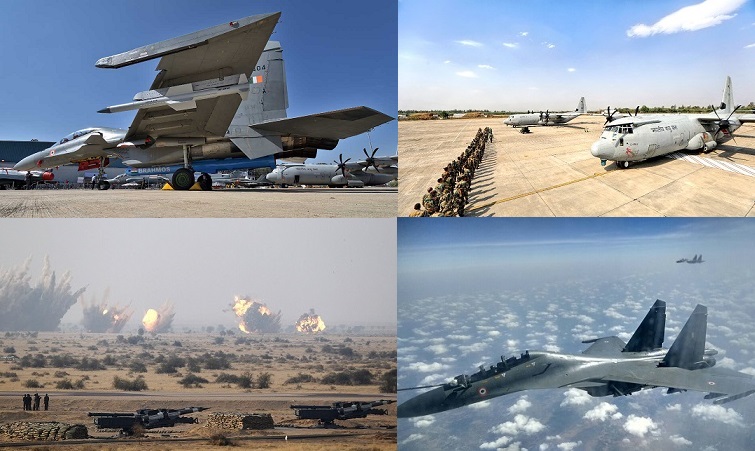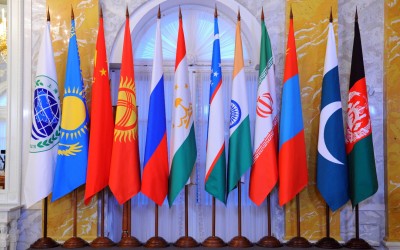
Glimpses of Gagan Shakti mega combat drill conducted by the IAF. Photos: Twitter/IAF
NEW DELHI (PTI): The 13-day long mega military exercise by the Indian Air Force achieved more than its stated "objectives", Air Chief Marshal B S Dhanoa said Monday, indicating its readiness to deal with a hostile Pakistan and China almost simultaneously.
Two days after curtains came down on Gagan Shakti – the biggest exercise by IAF in three decades – Air Chief Marshal Dhanoa said over 11,000 sorties were carried out by combat, transport and rotary wing aircraft of the force to test its combat readiness.
"All men and women of the IAF rose to the occasion and achieved things beyond our stated objectives," the IAF Chief told PTI in an interview.
As part of the massive drill from April 8 to 20, the IAF deployed its entire war waging machinery for the pan-India exercise with fighter jets, equipped with strategic weapons like BRAHMOS and Harpoon anti-ship missiles, carrying out deep penetration strikes to revalidate its strategic reach.
"We achieved relocation and rebalancing of assets from one sector to another in 48 hours," Dhanoa said. "The overall objective of Gagan Shakti was fully achieved," he said without elaborating.
Explaining the significance, a senior IAF official said the objective of the rebalancing and relocation was to quickly flatten the enemy in one front and redeploy the assets in another sector within 48 hours – in a possible two-front war scenario.
He said over 1,400 IAF officers and 14,000 personnel were part of the exercise for which preparations started around nine months back.
Dhanoa said the IAF achieved all parameters of serviceability, surge operations, relocation of resources and joint operations with the Army and Navy during the exercise which were crucial aspects of the war fighting machinery.
The combat drill was carried out at a time when China is increasing its assertiveness along the borders with India and Pakistan has been continuing its skirmishes along the Line of Control in Jammu and Kashmir.
The exercise covered all terrains including desert, high altitude areas like Ladakh, maritime sphere and almost all possible war scenarios were rehearsed on a real time basis.
"We carried out the exercise thinking as if we are going to fight a war," said a senior IAF official.
When asked about reports of IAF having carried out "strikes in the Malacca Strait," Dhanoa categorically denied it. Officials said the IAF demonstrated its ability to reach maritime targets as far away as 4,000 kilometers in the Malacca Straits but the force stuck to the targets provided by the Indian Navy, none of which were in the waterway around Malaysia, Singapore and Indonesia.
During combat drills near Sino-India borders, the IAF significantly focused on inter-valley transfer of troops considering various possible situations of conflict and taking a lesson from the Doklam standoff.
The exercise also focused on flexible use of airspace, joint maritime air operations with the Indian Navy, joint operations with the Indian Army, simulated combat search and rescue for effective extraction of downed aircrew behind enemy lines among others, the officials said.
They said the aim of this exercise was to ensure real time coordination and deployment of air power in a short and intense battle scenario and the objective was fully achieved.
The officials said the concept of network centric operations and long range missions were tested effectively.
They also said Pakistan and China were informed about the mega exercise.
The officials said state-run defence organisations such as Defence Research and Development Organisation, Hindustan Aeronautics Ltd, Ordnance Factory Board etc. also provided adequate support. Defence Minister Nirmala Sitharaman was impressed by the ordnance efficiency, they added.
Ensuring serviceability of fighter aircraft and various missile systems were a priority area and IAF succeeded in its endeavour, the officials said.
The serviceability of surface-to-air missiles were around 97 per cent while serviceability of fighter jets were close to 80 per cent, they said.
Serviceability refers to availability of an aircraft or a weapon system for deployment. The IAF has been struggling to maintain high serviceability levels of its platforms due to difficulty in getting required spares.
Similarly, the IAF could ensure high levels of dispatch reliability which refers to ability to make the serviceable flying platforms airborne as and when required, the officials said.
 Previous Article
Previous Article Next Article
Next Article













The Indian Air Force, in its flight trials evaluation report submitted before the Defence Ministry l..
view articleAn insight into the Medium Multi-Role Combat Aircraft competition...
view articleSky enthusiasts can now spot the International Space Station (ISS) commanded by Indian-American astr..
view article